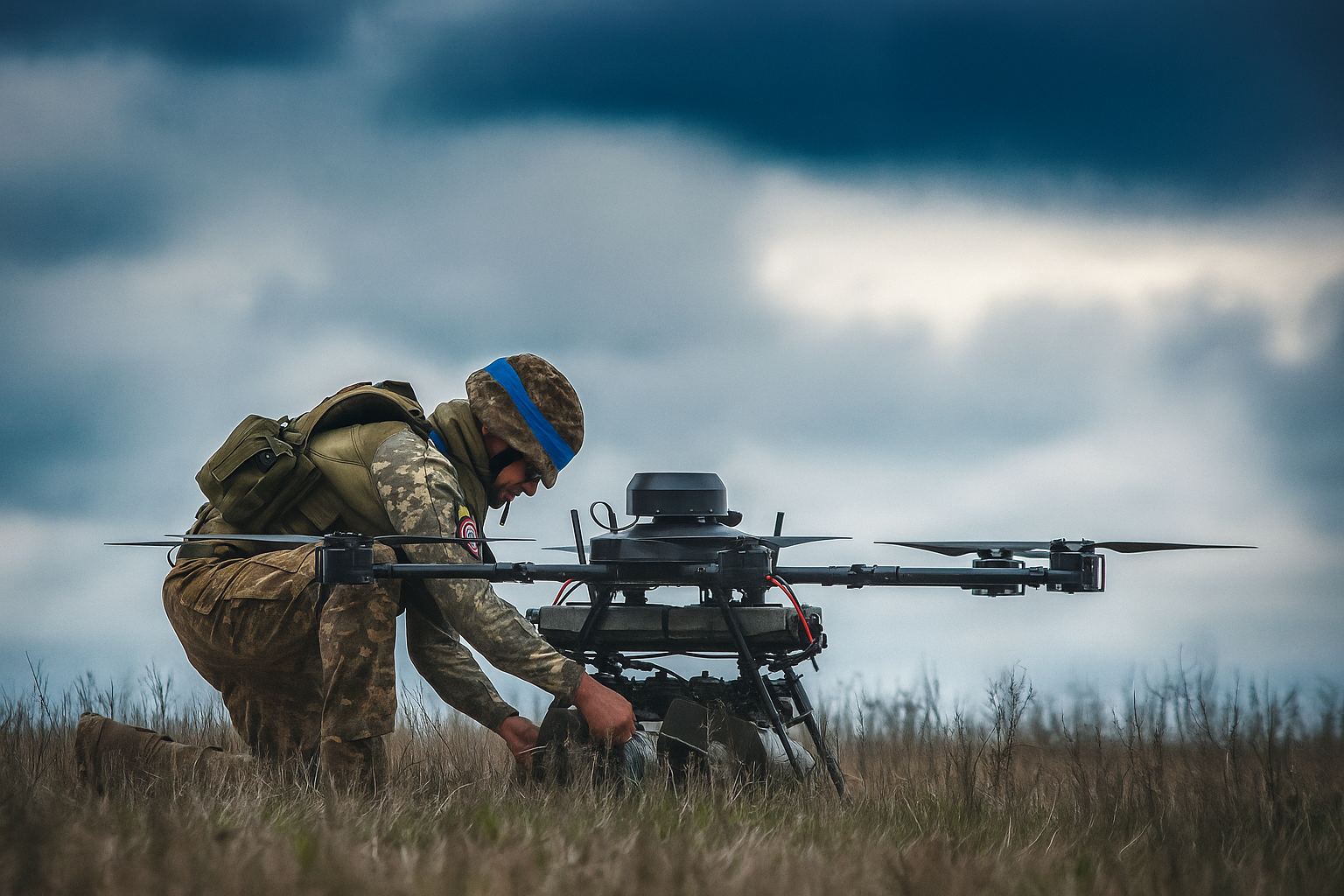
1. Setting the Stage: Timeline & Strategic Context
- Pre-2022: The foundations were laid with basic ISR drones like DJI Mavic; Russia experimented with UAVs in Syria and Nagorno-Karabakh, but development remained slow defensescoop.com+15csis.org+15insidefpv.com+15.
- February 2022: Full-scale invasion triggers explosive growth in battlefield UAV deployment, driven by necessity on both sides ft.com.
- Mid‑2022 onward: Ukraine and Russia rapidly field loitering munitions (kamikaze drones), FPV systems, and counter‑drone tactics—a high-speed arms race unfolding live longwarjournal.org+8ausa.org+8spectrum.ieee.org+8.
2. Key Drone Systems in Action
🇺🇦 Ukrainian Drones
- Aerorozvidka R18: Octocopters used for ISR and precision strikes on tanks and fortifications since 2019; by mid‑2022, more than 20 active crews destroyed 100+ enemy vehicles en.wikipedia.org.
- Punisher (UCAV): First deployed in 2022, use catapult launches and modular payloads; over 100 trained crews by 2022 en.wikipedia.org.
- AQ‑400 “Scythe”: Mass‑produced since late 2023; designed for long-range kamikaze attacks with up to 500 units monthly en.wikipedia.org.
- Ghost Dragon (KrattWorks): ISR quad equipped with neural‑network optical navigation to resist jamming and GNSS spoofing understandingwar.org+3spectrum.ieee.org+3csis.org+3.
🇷🇺 Russian & Allied Drones
- ZALA Lancet: Loitering munition capable of striking air defense systems, tanks, naval targets; product 53 variant supports semi-autonomous swarming en.wikipedia.org+1en.wikipedia.org+1.
- Shahed‑136 (Geran‑2): Iranian‑built drones deployed by Russia en masse; up to 6,000 purchased in 2023. Used primarily in saturation attacks ausa.org+5en.wikipedia.org+5en.wikipedia.org+5.
- Baba Yaga Octocopters: Repurposed agricultural drones delivering thermal warheads or serving as “mother-ships” for swarms thesun.ie+2en.wikipedia.org+2reuters.com+2.
- V2U Loitering Munition: Debuted June 2025; reportedly AI‑enabled and potentially swarming-capable longwarjournal.org+1csis.org+1.
3. Technology at War: Space Autonomy’s Role
- AI & ML Enhancements: Drone systems increasingly use visual‑based navigation, landmark detection, frequency‑hopping comms, machine vision—empowering operations in EW environments understandingwar.org+2spectrum.ieee.org+2defensescoop.com+2.
- Space-Enabled ISR: Commercial satellite imagery (e.g., Planet, Maxar) and government systems supply real-time targeting intel .
- Swarming & semi-autonomy: Mixed human-machine control; semi-autonomous targeting present in Lancet, V2U, and Ukrainian systems, but full autonomy remains rare businessinsider.com.
4. Notable Episodes
- FPV Drone Escorting Surrendering Russian Soldier (June 2025): Magyar Birds’ F10 drone guided a Russian soldier toward Ukrainian lines—first recorded capture via drone businessinsider.com.
- Operation Spiderweb (June 5, 2025): AI-guided FPV drones like “Osa” struck deep within Russia, reportedly damaging dozens of aircraft at airbases ft.com+1apnews.com+1.
- Odesa Drone Attack (June 20, 2025): Russia launched 86 drones; Ukraine shot down or jammed 70% using combined air defense and EW tactics reuters.com+1spectrum.ieee.org+1.
5. Tactics & Countermeasures
- Electronic warfare: Ukraine deploys thousands of jammers; drones counter with anti‑jamming navigation and fallback autonomy spectrum.ieee.org.
- Kinetic interception: Low-tech shotguns proved effective against optic‑fiber drones; net guns and FPV interceptors further deter airborne threats businessinsider.com+1spectrum.ieee.org+1.
6. What’s Next? Predictions & Implications
- AI‑enabled swarms: Both nations rapidly prototype semi-autonomous, cooperative attack systems (Lancet product 53, V2U, Ukrainian mother‑ship drones) en.wikipedia.org+1csis.org+1.
- Strategic satellite support: Enhanced integration of ISR satellites with drone ops boosts operational depth and targeting precision.
- Global ripple effects: At the Paris Airshow, “wingman” drone programs drew inspiration from Ukraine lessons; NATO countries accelerating CCA drone development reuters.com.
- Doctrinal change: Russia formalizing unmanned forces by late 2025; Ukraine scaling drone procurement with plans for millions of UAVs .
- Battlefield normalization: Expect affordable, jamming-resistant drones, evolving drone counters, and increasingly autonomous tactics to shape future wars.
✍️ Final Thoughts
The Ukraine conflict has fundamentally accelerated drone warfare into a new era—driven by necessity, enabled by civilian innovation, and amplified by space-enabled ISR. Here’s what stands out:
- Autonomy at scale is still nascent, but partial autonomy already plays a pivotal battlefield role.
- Space and drone ecosystems entwined: satellite‐guided targeting, jam resistance, and deep‐strike ops highlight space autonomy’s centrality.
- Doctrinal and industrial shifts: procurement cycles condense to weeks, commercial startups integrate into military structures.
This evolving drone–space convergence spells a future where air–space autonomy isn’t just an add-on—but a central pillar of 21st‑century warfare.
S-11